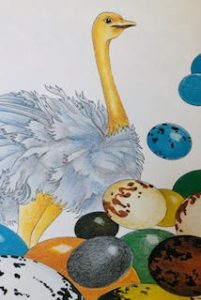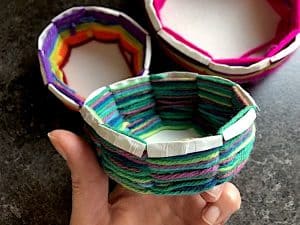Hello Hello St Thomas’ Families!
 Mmmmmmmm. I stumbled across this wonderful illustration last week in a corner of my desk where I save little things too unusual to just throw away or recycle. The loving image was from a calendar a few years ago, during the month of February, and I smiled looking at the art and remembering why I wanted to hold onto it. Then I flipped the page over to see what my month of February looked like in 2015. That was when I still wrote everything on the calendar on the kitchen wall, before I converted to my iPhone calendar and a planner to tote around with me. There were the many, many scribbles and scrawls of a schedule of a family of five going in a bazillion unimaginable directions…
Mmmmmmmm. I stumbled across this wonderful illustration last week in a corner of my desk where I save little things too unusual to just throw away or recycle. The loving image was from a calendar a few years ago, during the month of February, and I smiled looking at the art and remembering why I wanted to hold onto it. Then I flipped the page over to see what my month of February looked like in 2015. That was when I still wrote everything on the calendar on the kitchen wall, before I converted to my iPhone calendar and a planner to tote around with me. There were the many, many scribbles and scrawls of a schedule of a family of five going in a bazillion unimaginable directions…
…a pace and breadth of activity that contrasts so sharply with where we are right now. I just sat and breathed deeply in this realization. For many of us, we have hit a pause in how life “should” be. This can be uncomfortable, scary and disorienting. We may feel sad and disappointed for our children who have been denied the things we’ve hoped for them. AND…It’s here I turn for my best inspiration and reality check: our children. They are the ones so suited to “trust the process” and open our eyes to perspectives that may have never occurred to us, no matter how young they are. This is one of the reasons I relish teaching our STEAM program with them. I say “with” because most of our best curriculum, if we need to use that big word, comes from their deepest questions, or surprising discoveries or even their most surprising fears. They have been the ones who have stopped me in my tracks with comments and questions or requests to do something in a different way than I’d planned. They have been my most valuable teachers. They have planted seeds of joy and delight in whatever theme we’ve explored and have piqued my curiosity to dig deeper into an area that’s thrilled them. So with this in mind, I have two stories to share this week with you….
The first brings to life the image I shared above with you. I feel as if those hands are mine, so carefully tending with the greatest of care (and gratitude for your sharing them with me), your hopeful sprouts growing so bravely towards the sun.
It’s called “Plant a Kiss.”
Maybe you are planting cheery flowers in a pot by your doorstep, or maybe you are planning your first raised vegetable garden…whatever you are planting and cultivating, the most valuable seed to cultivate is ……LOVE….and it spreads! And it’s not invasive!
Maybe you are very new to gardening? Did you know that most anything can be a garden? One of my favorites was in an old pair of my boots. I wonder what unusual things you could find to plant a garden. In this next book, someone just might decide to use their old…tuba! Here’s the link for “Anywhere Farm”:
Planting seeds, no matter how many and no matter where, can be such a beautiful hobby that brings joy in quiet and meaningful ways. We all have the ability and desire to nurture and it brings out the best in each of us. I invite you to try it. See what makes you happy to plant. One of my favorite seed companies is Botanical Interests. Check out the heirloom sunflowers! All sizes up to 12 ft! Maybe a patch of mammoth sunflowers for your family to shelter under, for the birds to enjoy an autumn seed buffet and our much loved and needed pollinators to tickle all summer long with their fuzzy yellow pollen-collecting legs? If you’d like, I have lots of different things I’m able to share from my garden so that’s an option too. Please just reach out to me!
 Here’s another idea of something to do as a family…not only is it a fabulous secret place to curl up in the heat of summer but will also give you pick-your-own veggies for dinner. Pole beans twine so well on whatever support you can find…fallen tree branches leaned on each other work just as well as bamboo poles or whatever you have readily available. The flowers are loved by insects and birds (some flower red, a hummingbird magnet) and produce delicious beans for your picking after the flower fades. You can even add another climbing plant seed to intertwine with the beans such as morning glories or hyacinth bean vine that is not edible but grows the COOLEST purple flowers then pods perfect for taking apart with tiny fingers! Heart shaped leaves and blooms linger until the end of fall.
Here’s another idea of something to do as a family…not only is it a fabulous secret place to curl up in the heat of summer but will also give you pick-your-own veggies for dinner. Pole beans twine so well on whatever support you can find…fallen tree branches leaned on each other work just as well as bamboo poles or whatever you have readily available. The flowers are loved by insects and birds (some flower red, a hummingbird magnet) and produce delicious beans for your picking after the flower fades. You can even add another climbing plant seed to intertwine with the beans such as morning glories or hyacinth bean vine that is not edible but grows the COOLEST purple flowers then pods perfect for taking apart with tiny fingers! Heart shaped leaves and blooms linger until the end of fall.
And lastly, since we are focusing on the “process” and seeing where it takes us with curiosity and care, I’ve included a link for many process art ideas to enjoy throughout the summer with your family that are simple in terms of supplies. Please feel free to share photos with me by email to post on our sites. We could host an online art show!
Thank you all for “bean” the wonderful families you are…keep growing, keep hoping, keep looking forward and know I am here for you ….it’s an honor to guide and learn alongside your children.
With big love,
Miss Amy (please keep reading below..more fun!)
P.S…..WHAT FUN it was to laugh with you all and send BIG air hugs during our parade at school last week! After a few chats as you drove by in your wonderfully decorated cars and wide grins, I’ve included a bunch of ideas/activities inspired by you!
The Schuylkill Center for Environmental Education is offering awesome Thursday night LIVEs (on-line): June 4th (7-8pm) is nature trivia!
On Virtual Schuylkill Saturdays (10:30-11am), dive as a family into a new nature topic each week with one of the center’s environmental educators on Facebook Live and continue the learning fun with activities to explore at home.
For more info, see schuylkillcenter.org (you’re welcome for the spelling…hahahah!)
The Barnes Foundation is offering the Barnes From Home Family Art Time. Currently there are several weekly activities posted with details and supplies, for families of all ages, adults included, to create art and learn from the art and objects in the Barnes collection. If you love art, sign up for their weekly “takeout” art lesson email, it’s free. You’ll find a myriad of ideas for art learning and inspiration on their website.
For those of you exploring the wonder of the Earth and all the other planets, if you’d like to create your own solar system with balloons and simple, homemade paper mache paste, here is a great recipe from Red Ted Art! I’ve also tried the paper clay from this site…so much fun.
Redtedart.com (search paper mache paste from flour/paper clay)
PBS.org has featured Michele Obama reading favorite stories during the month of May. The readings (with some special guest appearances) are accessible through the PBS Facebook page and Youtube Channel.
www.readtogetherbetogether.com, and companion literacy resources are available on pbskidsforparents.org.
And, because who can resist three ingredient, homemade puffy paint that is both art and science in the making?
3-Ingredient Homemade Puffy Paint
Make Homemade Puffy Paint with 3 kitchen ingredients. You put it in the microwave and it puffs right up!
Keyword: Homemade Puffy Paint
Author: Jackie Currie
Ingredients
- 1 cup all purpose flour
- 1 and 1/2 tsp baking powder
- 1/4 tsp salt
Instructions
- Combine flour and salt in a small bowl.
- Add a bit of water and stir until you get a smooth, thin paste (about the same consistency of stirred yogurt).
- Add food coloring, and mix well.
- Put painting into microwave for 30 seconds and watch it puff up!
- Allow to cool before handling.
xoxoxoxoxoxoxoxoxoxoxoxoxoxoxoxoxoxoxoxoxoxoxoxoxoxoxo


 Since some ingredients might be challenging to find with less trips to the grocery store, I’ve included two dough recipes that are simple and require just a few ingredients. They are both so easy to put together and making them is a terrific family cooking experience. The dough will be ready even before you decide on your toppings!
Since some ingredients might be challenging to find with less trips to the grocery store, I’ve included two dough recipes that are simple and require just a few ingredients. They are both so easy to put together and making them is a terrific family cooking experience. The dough will be ready even before you decide on your toppings!
 Now just bake at 450 degrees for 15-20 minutes (large pizza) or 10-15 minutes for the smaller pizzas! YUM!
Now just bake at 450 degrees for 15-20 minutes (large pizza) or 10-15 minutes for the smaller pizzas! YUM!












 If you would like to make decorative eggs another way that builds strong hands for little people, try cutting out egg shapes in various sizes from cardboard cereal or pasta boxes or paper plates. Using a small piece of aluminum foil, wrap the egg in foil and lightly brush with glue. Decorate with small pieces of colored paper, magazine paper, fabric, ribbon, yarn or buttons…let your creativity run wild! You could do one with all nature items. String them together to make a banner, or use a short ring cut from a paper towel roll as a stand to display on your family table.
If you would like to make decorative eggs another way that builds strong hands for little people, try cutting out egg shapes in various sizes from cardboard cereal or pasta boxes or paper plates. Using a small piece of aluminum foil, wrap the egg in foil and lightly brush with glue. Decorate with small pieces of colored paper, magazine paper, fabric, ribbon, yarn or buttons…let your creativity run wild! You could do one with all nature items. String them together to make a banner, or use a short ring cut from a paper towel roll as a stand to display on your family table.






























